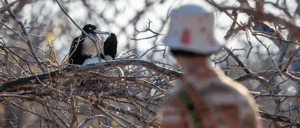
NORTH SEYMOUR ISLAND
Ready for your adventure?
Dive into nature with us and see what makes these islands unique.
Tap below to get started!
VISITOR SITES
North Seymour
It is a fascinating place to see blue-footed boobies nesting and frigatebirds colonies.
This is perhaps one of the busiest tourists destinations on the Archipelago, right next to Baltra Island (where the airport is located) and not far from Santa Cruz. North Seymour is a fascinating place with open nesting grounds of blue-footed Boobies and the archipelago’s largest colonies of Great and magnificent Frigate birds. You will also encounter sea lions, swallow-tailed Gulls and on a lucky day, you might even come across a Galapagos Snake.
North Seymour is a tectonic uplift. In terms of its geology, it is the result of the earth’s crust uplifting from below sea level, and this has created a potpourri of geologic formations. This phenomenon causes the island cliffs to drop dramatically into the ocean. Crustaceans, reptiles and plant species can be found here, many of which inhabit the intertidal zone (or foreshore).
The ground is at and strewn with Palo Santo or holy stick trees (a type of sandalwood noteworthy for its strong aroma) and gray saltbush, among white-splashed rocks. While walking, make sure you don’t step on any blue-footed booby nests. They won’t move, but you can. Respect their space and always follow the trail.

- Disembarking: Dry.
- Type of Terrain: Rocky & Sandy.
- Difficulty: Medium.
- Activities: 25 min glass-bottom boat / 45 min deep snorkeling / 1 hour 45 min hike.
- Highlights: Blue-footed Boobies perform their courtship dance in the more open areas; Swallow- tailed Gulls perch on cliff edges; Great Blue Herons, Lava Herons, two species of frigate birds, and endemic snakes can also be spotted. You’ll find endemic land iguanas 3.9 ft (1.20 m) in length. Despite the tremendous surf pounding the outer shores, sea lions haul their slick bodies onto the beach and can be found together with marine iguanas. The vegetation is sparse and typical of arid zones.
Wildlife by visitor site
GALAPAGOS PELICAN
LAND IGUANA
Gallery















Suggested items
SNORKELING
Location map

CHARLES DARWIN JOURNEY
This is the first Island visited by Charles Darwin, and his first impression of the dry coast he saw was of a deserted and isolated place. He did not find the tropical richness he expected, but he had the chance to collect the first specie that later on would be the start of his Theory of Evolution, the San Cristobal Mockingbird.